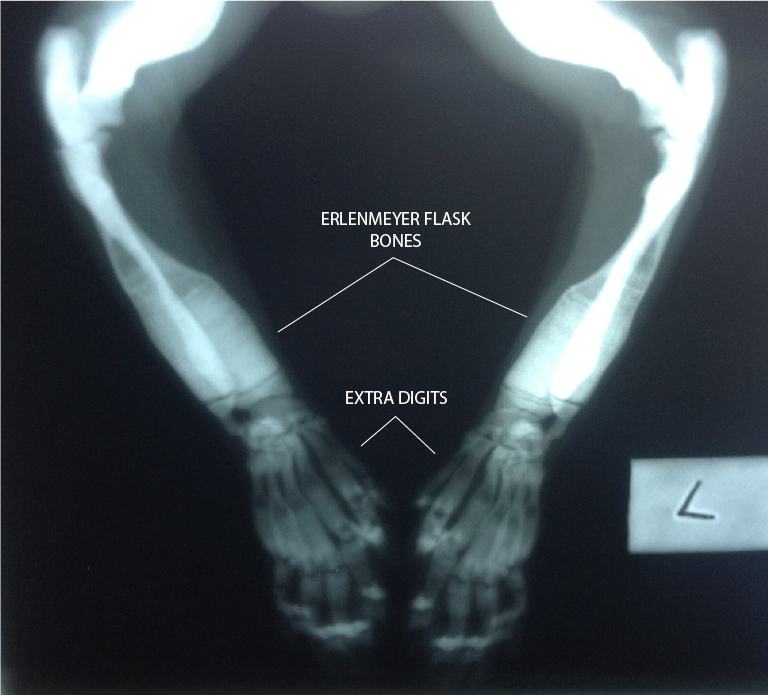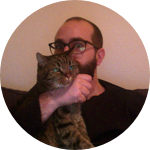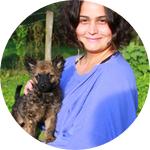About This Project
LilBub is a magical critter: she's a lovely cat with an extraordinary appearance. Her special traits are caused by alterations in her DNA. We want to find the cause of LilBub's appearance: we will sequence LilBub's genome and look for variants that could explain her unique looks. We will closely document every step of the process, from crowdfunding to experiments and analysis, and explain what we're doing as we're doing it.
Ask the Scientists
Join The DiscussionWhat is the context of this research?
LilBub is an unusually small cat with some traits that resemble known developmental disorders. She has extra digits on every paw, no teeth and a short snout, which is why her tongue hangs out. Also, her skeleton produces too much bone tissue, a rare disease known as osteopetrosis.
While LilBubs combination of traits is unique, we know humans, cats, dogs and mice that have certain subsets of these features. Often, such similar traits in different animals are caused by matching changes in their DNA.
We therefore think LilBub's looks could be caused by mutations in her DNA that resemble those found in patients and other animals. By sequencing and analyzing the whole genome of LilBub we want to identify this mutation.
What is the significance of this project?
Novel technologies and ever-decreasing costs are making genome sequencing a common practise for medical diagnosis and treatment. "Personalized medicine" is a buzzword. But how do we obtain a DNA sequence and how do we "read" that sequence?
Using LilBub's special looks we want to demonstrate how we can go from a blood sample to finding changes in the DNA that are responsible for a specific trait. We want to show non-researchers how you sequence a whole genome with state-of-the-art technology. How you then analyze sequence data and what additional information you can use to help interpretation. We also want to show the limits of genome analysis, demonstrating what you can and cannot conclude with certainty.
Finally: We are curious! We'd really like to know what makes Lil Bub so extraordinary!
What are the goals of the project?
During this project we will:
- Extract DNA from a blood sample of LilBub and sequence her genome
- Analyze the genome sequence and find candidate mutations that could be causing her phenotype
- Share the step-by-step process of a scientific project with the World.
As a consequence we hope to raise awareness about genetic testing for rare diseases.
Budget
The LilBubome is the brainchild of 3 scientists, driven by our curiosity to better understand cats & genetics. Since LilBub is at home on the Internet, crowdfunding seems the natural way to bring this project to life!
The vast majority of the money will be spent on sequencing the genome of LilBub. We will do this at the sequencing facility of the Max Planck Institute for Molecular Genetics in Berlin, where Daniel and Dario work. Here, the group is looking for disease-causing mutations in humans, and with the sequencing facility next door, we will have more direct help than if we used an off-site company.
Additionally, we need a small sum to ship a blood sample of LilBub to our lab in Germany, and to extract and purify DNA from the blood.
Stretch goal:
We'll do a low resolution analysis of about 50 Main Coons to find regions of the genome that are associated with Hypertrophic Cardiomyopathy. Then, we'd like to sequence 3 Main Coon cats to find mutations in these regions.
Meet the Team
Team Bio
We are scientists who are interested in understanding the genetic basis of why we look the way we look. In our day jobs we study genetics, developmental processes and malformations in humans, mice and even moles, and try to understand to what extent traits are hardwired in the DNA. We all have PhDs in biology, and we've collaborated on 'formal' research projects in the past.
We love our work, but sometimes we hear that what we do is far removed from the 'real world'. This is one of the reasons, why this project is so special to us: when we first learned about LilBub we saw this adorable little cat, and we also saw a connection to our research.
Therefore, apart from finding the mutation underlying LilBub's condition, we would like to show that genetics is not crazy and complicated, but something that's close to everyone and anyone who cares to get their head around it.
You can read more about us and our motivation to work on this project on the LilBubome blog page.
We have two experienced specialists that will help us with analysing the genome and interpreting the results:
Prof. Leslie Lyons - cat geneticists who heads the awesome 99 cat lives initiative which we encourage you to check out
Prof. Uwe Kornak - human geneticists who is (among other things specialist for inborn bone disorders
Daniel M. Ibrahim
I'm a scientist at the Max Planck Institute for Molecular Genetics in Berlin and study the genetic basis of developmental disorders in humans, which often affect only very few patients. The cat in the picture is Castro.
Scientifically, I care most about gene regulation, which means why any given gene is activated (or repressed) only in certain cells and tissues. Misregulation of genes is the molecular basis for many developmental disorders and changes in gene regulation are probably a major driving force of evolution.
If you (losely) connect these two points, you see how they drove me to experiment.com when I first learnt about LilBub.
I couldn't help but think of how similar her case is to patients born with a rare disease, only that she's a cat.
Uschi Symmons
I'm a molecular biologist, and my main interest is to understand how the instructions in our DNA determine the way we look. I've always approached this question by taking human disease or development as a starting point and then trying to figure out what the molecular causes are. Using this approach I've worked on a rare heritable disorder (Pseudoxanthoma elasticum) during my master thesis in Hungary. Later, for my PhD, I studied the origin of polydactyly (when people have more than 5 fingers) at the European Molecular Biology Laboratory in Heidelberg, Germany. Currently, I am working on imaging methods to count individual RNA molecules in mouse tissues, to get a better estimate of how variable gene expression is.
Apart from my research I'm also very interested in science outreach and engagement. During my PhD I helped out in lab practicals for high-school students and teachers. I translate TED (popular science) talks into Hungarian (my native language). I write a blog about sciency things and life in academia for anyone who's interested in those topics. And I'm really excited about the Lil Bub project!
Darío G Lupiáñez
I am a postdoctoral researcher working at the Max Planck Institute for Molecular Genetics in Berlin. My main scientific interest is to understand the nuclear organization of the genome and how its variations are related to evolution and disease. Besides a work, I consider science as my hobby.
Press and Media
Read LilBlog, our BUBome-related blog, or follow us on twitter @LilBUBome. or check faceBUBome
view video subtitled en español or Deutsch clickar hier
Check out LilBUB herself around the interwebs: LilBUB's homepage, faceBUB, @IAMLILBUB and instaBUB
Additional Information
We want you to be part of the project! When we talk to friends and family about our work, they are always curious, but often also daunted, because what we do seems complex and difficult to understand. But we believe that the basics of our research are not terribly complicated. Just like any other job, our work involves a lot of routine, trial-and-error, highs and lows.
Therefore, we want to use this opportunity to give you a behind-the-scenes look at genome analysis, documenting and sharing our work while we're doing it. We want to show you the actual work process, the mistakes we make, the wrong leads we'll follow and the dead ends we encounter. We want you to follow us while we're trying our hardest to understand the magic of Lil Bub, to ask questions and give us feedback!
Here are a couple of Bub fotos that are cool and you can nicely see some of Bub's morphological features.
Bonus Digits
Here you can see Bub's paws. She's polydactyl, which means that she has an extra digit on every paw next to the thumb. Cats normally have 5 digits on the forelimbs and 4 digits on the hindlimb. Bub has 6 and 5. Also check out the x-ray below.

Snout and Teeth
She doesn't have any teeth, but a short snout! Bub's bones grew very quickly, so that her snout probably did not have enough time to grow to the proper length before the cartilage template mineralized. That process likely also inhibited her teeth to grow through the jaws.

X-rays
Underneath her skin, her bones look quite unusual. On X-rays, you don't see the bone cavity as you would expect. Instead, you see highly mineralized (white) bones that are very thick at the ends. There are human patients known with these type of bones, called Erlenmeyer flask bones. Maybe Bub's mutation and the mutations found in these patients are similar? We'd really like to find out

Project Backers
- 248Backers
- 126%Funded
- $8,225Total Donations
- $33.17Average Donation


